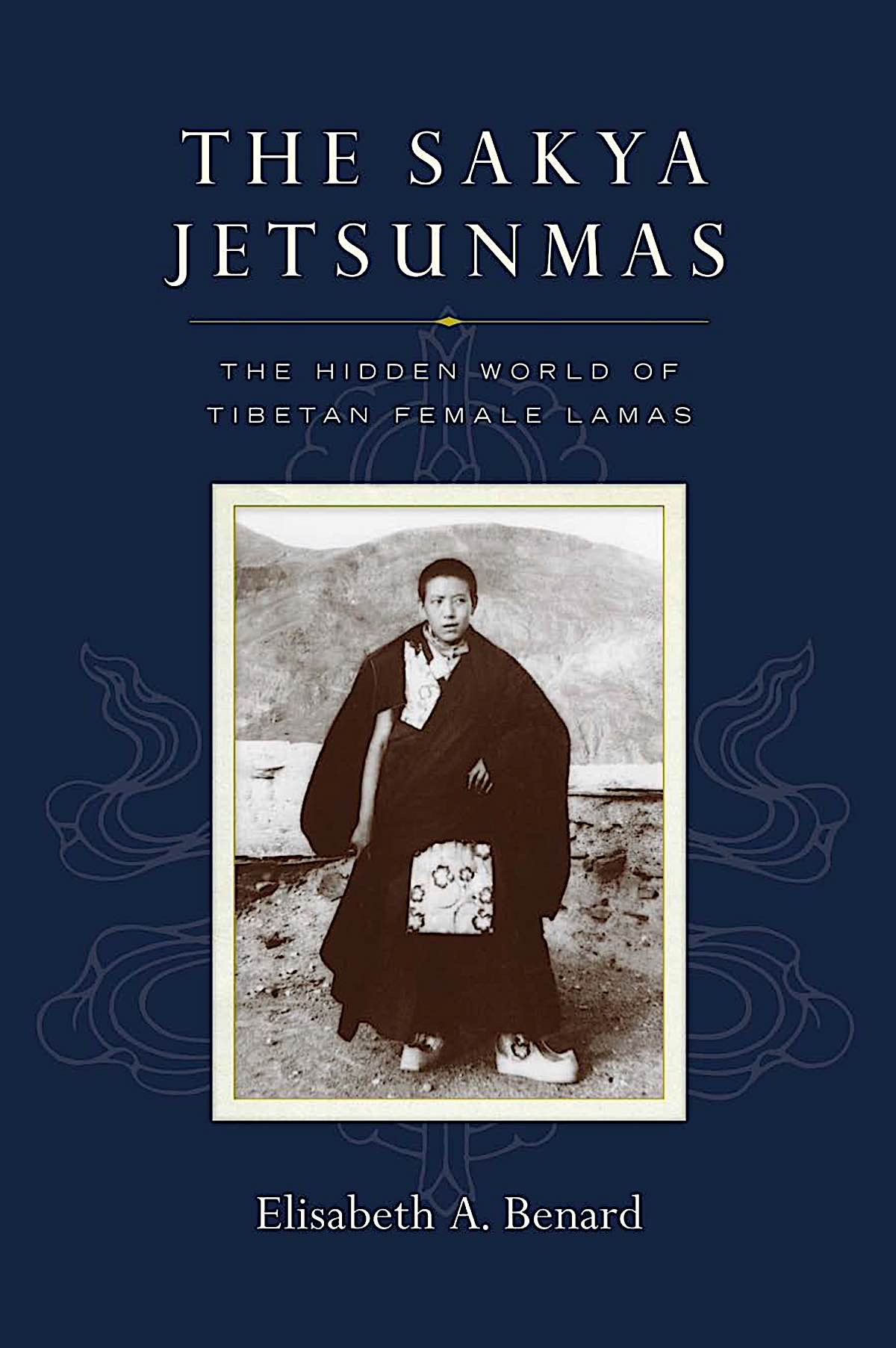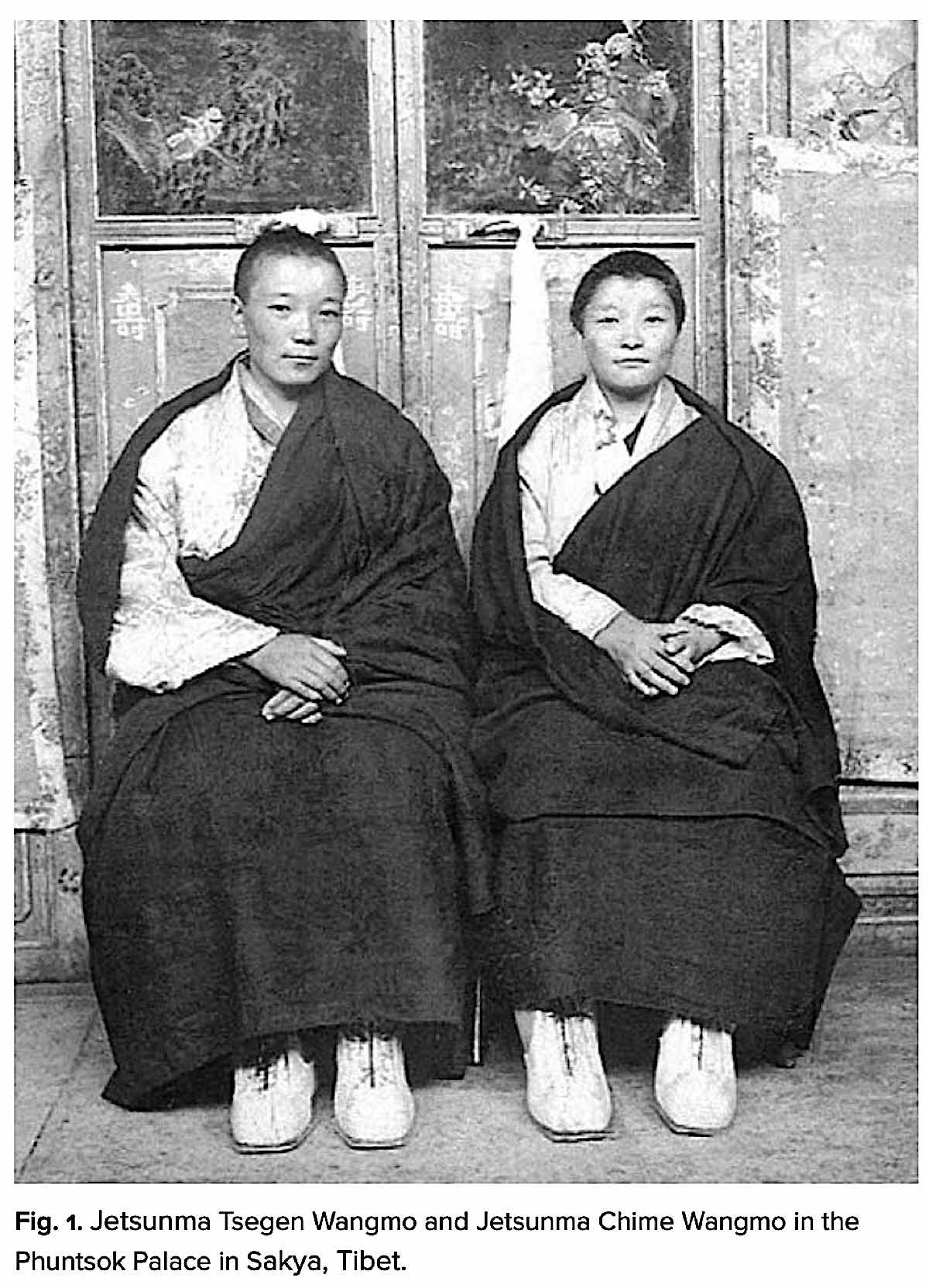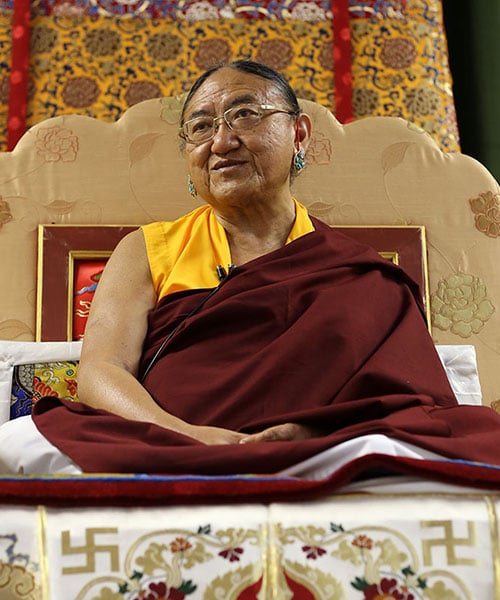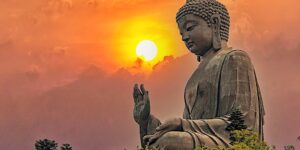“The Sakya Jetsumas — The Hidden World of Tibetan Female Lamas” — spiritual biographies of the great female meditation masters
There can be no doubt of the vast contribution of the great female wisdom masters of Tibetan Buddhism, yet with the notable exception of Yeshe Togyal and Machig Labdron, there are precious few stories of their lives. Elisabeth Benard, Ph.D., set out to explore the secret world of the great meditation masters of the Sakya tradition — masters who happen to be among the greatest female lamas in Tibetan Buddhism. Their stories are inspirational and fascinating.
We were delighted that Elisabeth Benard agreed to a revealing interview into this world of the great Sakya Jetsunmas. She spent years researching their stories — speaking with His Holiness the Sakya Trichen and his sister Her Eminence Jetsun Kushok — and released a wonderful biography of these masters: The Sakya Jetsunmas: the Hidden World of Tibetan Female Lamas.
- Available from your favorite bookseller, or Amazon (details below.)

While this highly readable book is certainly a valuable scholarly contribution, Elisabeth writes an engaging and fascinating account that goes beyond the riveting history — an easy-to-enjoy book that should appeal to both Tibetan Buddhists and readers of biographies.
What does his Holiness the Sakya Trichen think of this exploration of the fascinating lineage of the Khon family? In his own words:
“This invaluable work on the Sakya Jetsunmas offers an intimate look into the lives of four exceptional yoginīs who were outstanding by virtue of both their birth and their spiritual accomplishments. Biographies of realized female spiritual adepts are few and far between, and until now this has also been true of the Jetsunmas of the Khon family. And so, it is a huge boon that the pages of this wonderful book are so abundantly filled with rich details of the Jetsunmas’ extraordinary lives. The book is filled with wonder and is bound to inspire and instruct not only female practitioners but anyone who is walking the spiritual path in earnest. I pray that it may lead uncountable beings to enlightenment.” —His Holiness the Forty-First Sakya Trichen
What motivated you to write this book?
Buddha Weekly: What motivated you to write about the remarkable Jetsumas of the Sakya Lineage? What was the motivating “aha” moment that inspired the book?
Elisabeth Benard: Since I was in high school, biographies have entranced me. In the late 1970’s, I was working during the summer near Wall Street in New York City. During my lunch break,
I would sit on a bench near the East River. This is where I read my first Tibetan biography, The Life of Milarepa (the cotton clad yogi). Suddenly I was transported from a major financial center of the world to the Himalayas. I read with fascination the trials and triumphs of the great yogi. Milarepa and Marpa, his teacher, are viewed as a paragon of the lama/disciple relationship. But, also, I was intrigued by Marpa’s wife, Dagmema, who helped Milarepa in a more loving manner than her husband. Over the decades, being interested in Tibetan female practitioners I sought out the few biographies available, such Machik Labdron.
I discovered the Sakya jetsunmas accidentally. I noticed that in the Sakya guru lineage of Vajrayogini, there was a woman, Chime Tenpai Nyima. His Holiness Sakya Kyabgon Gongma Trichen Rinpoche (the 41st Sakya Trizin) thus told me that she was a Sakya Khon jetsunma. This began my long research, perhaps for fifteen years, on and off whenever I had time.
During that time, I discovered that almost no one knew about the jetsunmas, not even scholars who were interested in writing about Tibetan female practitioners. I am very pleased that I can present to others a book filled with biographies of Tibetan female practitioners. As my friend, Alexander Gardner, director of the Treasury of Lives: A Biographical Encyclopedia of Tibet, Inner Asia, and the Himalayan Region (treasuryoflives.org) said, “We have so few biographies of women that we look at your book as a gold mine!”

Your background?
Buddha Weekly: Can you tell us a little about your background?
Elisabeth Benard: I have been involved with Tibetan Buddhism since the late 1970s. My first teacher was the third Dezhung Rinpoche (1906-1987). At the time I was searching for a Buddhist teacher, not necessarily a Tibetan one. One day a friend told me that there would be an initiation in the evening and suggested that I join him.
I worried about an “initiation”; it sounded cultish to me. Accompanying him to the initiation, I sat way in the back to observe and perhaps to exit quickly if needed. An elderly man arrived, and the audience showed him great respect. A ceremony occurred with chanting, incense wafting, bells tinkling and people repeating things. I really had no idea what was happening. When the ceremony finished, I decided to leave. But suddenly, I felt compelled to go towards the lama. Completely bewildered and unable to resist, as I approached this elderly man, I began to cry uncontrollably. When I was directly in front of him, he was beaming and blessed me with a small Buddha statue on my head. From that moment, I knew that I found my teacher. Later I learned that the initiation had been an empowerment of the Bodhisattva of Compassion, Avalokitesvara.
I consider Dezhung Rinpoche, one of my root gurus. Through him, I met Sakya Kyabgon Gongma Trichen Rinpoche and Her Eminence, Jetsun Kushok a few years later. They are my three main root gurus, whom I cherish.

Jetsunma you especially admire?
Buddha Weekly: Was there one of the Jetsumas that you especially admire? What is it about her life that inspired you?
Elisabeth Benard: I like each of the jetsunmas for different reasons. Chime Tenpai Nyima was remarkable because she is the only woman in two main teachings lineages. Tamdrin Wangmo was a lama who loved to teach. She sought different teachings which were being lost and she was able to preserve the traditions. Pema Trinlei was originally a teacher but later in life, she decided to be a yogini living in a cave. Jetsun Kushok married due to the circumstances of becoming a refugee. Being married and having four children did not prevent her from becoming a great lama. Each of the jetsunmas had her distinct life and chose different paths.
Working with His Holiness Sakya Trichen
Buddha Weekly: Can you tell us about your experience interviewing His Holiness Sakya Kyabgon Gongma Trichen Rinpoche?
Elisabeth Benard: His Holiness is the epitome of wisdom and compassion. He is a very kind and caring lama who tries to help in any way possible. I feel fortunate to have a refuge in His Holiness and Her Eminence. When I approached His Holiness with the idea to write about the Sakya jetsunmas, he was delighted and encouraging. It felt as if he had been waiting for someone to learn about the Sakya daughters and about how his elder sister, Her Eminence Jetsun Kushok was part of this illustrious lineage. I interviewed him numerous times, both in India and the United States. He told me stories from the oral tradition, occasionally gave me texts and related his own memories. In the beginning I thought that I would write some brief biographies, but as I collected the information, it became apparent that I could write an entire book.

Jetsunmas who shaped numerous lives
Buddha Weekly: “Having this awareness, these jetsunmas are remembered as great lamas who shaped numerous lives in Tibet, just as Jetsun Kushok trains and guides Buddhist practitioners today throughout the world.” From your book. Can you discuss your experience interviewing Jetsun Kushok?
Elisabeth Benard: Jetsun Kushok is a gracious person. As an aside, she has delicate hands which are beautiful to watch when she is making mudras. When you visit her, she gives you her full attention and seems to know what you want before you mention it. At times, during numerous interviews, she told me the answer before I asked the question.
Also, she was good at directing me with respect to what was more important. In the beginning I knew very little about the subject and she helped me understand the history and dynamics of the Sakya Khon family. She explained who are the jetsunmas, what are some major empowerments for them and what is a daily life routine for a jetsunma.
It was, also, interesting to hear the same story from His Holiness and Her Eminence. Sometimes, each would give me some extra information which helped to make the story more complete. I felt fortunate to have this unique opportunity to interview both of them many times over the years.

How long did it take to research?
Buddha Weekly: How many years did it take to research this incredible book? What was your process?
Elisabeth Benard: It wasn’t a smooth process since I was working full time and didn’t have much time to devote to research and writing the book. Probably it took about 15 years. I relied very much on the genealogies of the Sakya families. Though these genealogies are extensive for the Sakya Trizins and the sons, the information about the daughters is very scant. It required a lot of reading for a few morsels about the jetsunmas. The other source which consists of two large volumes is Autobiographical Reminiscences of Sakya Trizin Dragshul Trinlei Rinchen, the grandfather of His Holiness and Her Eminence. My Tibetan husband, Nima Dorjee, helped me with this considerable work. Together, we perused over a thousand pages of the grandfather’s autobiography to find information.
Much of the oral history is from both His Holiness and Her Eminence. Sometimes, they were so busy that I had to wait a year or two for an interview. At other times, I would meet someone who knew the family well and suddenly I received additional information. For example, in 2009 while I was visiting Sikkim, I decided to visit the Ngor Sakya Monastery in hopes of finding someone who knew the family. The first time that I went, I didn’t meet anyone. However, during the second time, I met the abbot, Khenpo Tenzin Dawa, who had many stories about the family, especially when they arrived in Sikkim and India. If I hadn’t return for the second time, I would never have met the abbot. These unexpected encounters occurred numerous times and I was able to gather much more information that made the stories more interesting and varied.
The unfailing loyalty of Jetsun Lochen
Buddha Weekly: You tell the wonderful stories of inspirational Jetsumas, but you also frankly discuss their difficulties and some of the inequities. I was especially moved by the loyalty Jetsun Lochen despite the challenges presented by her teacher. Perhaps you could tell this story? I like the way you emphasized Jetsun Lochen’s unfailing loyalty despite being ignored by her teacher.
Elisabeth Benard: In Tibetan Buddhism, lamas stress that practice trumps gender. If one practices diligently, eventually one becomes enlightened. Every being has Buddha nature. However, as in many societies, people create differences and, in some cases, women have less opportunities to practice because of household and child raising responsibilities. In Tibet, the opportunities for women to be practitioners were limited. Whereas young men could attend and learn in well-funded monasteries throughout Tibet. Nunneries were small and rarely well-supported. Thus, when I discovered that the Sakya Khon families were committed to nurture and develop spiritual acumen impartially in both their daughters and sons, I was joyous. This family has kept this commitment that has extended for over a millennium.
Vajrayogini teachings from Dezhung Rinpoche
Buddha Weekly: What’s your favorite recollection from writing this book?
Elisabeth Benard: Since Dezhung Rinpoche was my first lama, I was delighted to be able to interview his younger sister, Ani Chime and his niece, Dagmo Kushok about Jetsunma Pema Trinlei. As they told me their encounter with Jetsunma Pema Trinlei in the cave and receiving the Vajrayogini teachings that Dezhung Rinpoche had requested, I felt transported to that extraordinary week. Later I was fortunate to receive the Vajrayogini teachings from Dezhung Rinpoche. From Jetsunma Pema Trinlei to Dezhung Rinpoche to his foreign students scattered throughout the world, the lineage continues. I find this astonishing.
The “take-away” of the book
Buddha Weekly: What is your overarching theme or purpose in writing this important book? What do you hope people will take away from reading it?
Elisabeth Benard: I like to be a trailblazer and reveal female lives which unknown. Though I had known His Holiness and Her Eminence for decades, I wasn’t aware that these jetsunmas even existed. I didn’t know that the title of Jetsun Kushok came from a lineage of over a millennium. I had discovered the jetsunmas without comsciously looking for them.
Spiritual biographies from all traditions have inspired me that some people are willing to pursue a spiritual path regardless of the difficulties or uncertainties. I am thankful that people have been pursuing the spiritual path for aeons and throughout the world. I think this makes a subtle but significant impact in our world. Hopefully when you read about these great jetsunmas, they will inspire you to continue your own spiritual journey.
Author Bio: ELISABETH BENARD
Elisabeth Benard, Ph.D. Columbia University in Tibetan Buddhism, was a professor of religion and the director of the Pacific Rim/Asia Study-Travel Program at the University of Puget Sound in Tacoma,
Washington. She is the author of Chinnamastā: The Aweful Buddhist and Hindu Tantric Goddess (Motilal Banarsidass, 1994) and numerous scholarly articles, and the co-editor, with Beverly Moon, of Goddesses Who Rule (Oxford University Press, 2000). Since her retirement, she has continued to pursue her interest in goddesses and spiritual women, compiling biographies of hidden yoginis in Tibetan Buddhism. Her spiritual practice has been under the guidance of the 3rd Dezhung Rinpoche, H.H. the 41st Sakya Trizin (now Trichen), and H.E. Jetsun Kushok.

About the Book
- Title : The Sakya Jetsunmas: The Hidden World of Tibetan Female Lamas
- Publisher : Snow Lion (March 1, 2022)
- Language : English
- Paperback : 320 pages
- ISBN-10 : 1645470911
- ISBN-13 : 978-1645470915
- Available in paperback and kindle
- On Amazon>> (this is an affiliate link), or at your favorite book seller.
- On Shambala’s site>>
Latest Features
Please support the "Spread the Dharma" mission as one of our heroic Dharma Supporting Members, or with a one-time donation.
Please Help Support the “Spread the Dharma” Mission!

Be a part of the noble mission as a supporting member or a patron, or a volunteer contributor of content.
The power of Dharma to help sentient beings, in part, lies in ensuring access to Buddha’s precious Dharma — the mission of Buddha Weekly. We can’t do it without you!
A non-profit association since 2007, Buddha Weekly published many feature articles, videos, and, podcasts. Please consider supporting the mission to preserve and “Spread the Dharma." Your support as either a patron or a supporting member helps defray the high costs of producing quality Dharma content. Thank you! Learn more here, or become one of our super karma heroes on Patreon.
Lee Kane
Author | Buddha Weekly
Lee Kane is the editor of Buddha Weekly, since 2007. His main focuses as a writer are mindfulness techniques, meditation, Dharma and Sutra commentaries, Buddhist practices, international perspectives and traditions, Vajrayana, Mahayana, Zen. He also covers various events.
Lee also contributes as a writer to various other online magazines and blogs.










